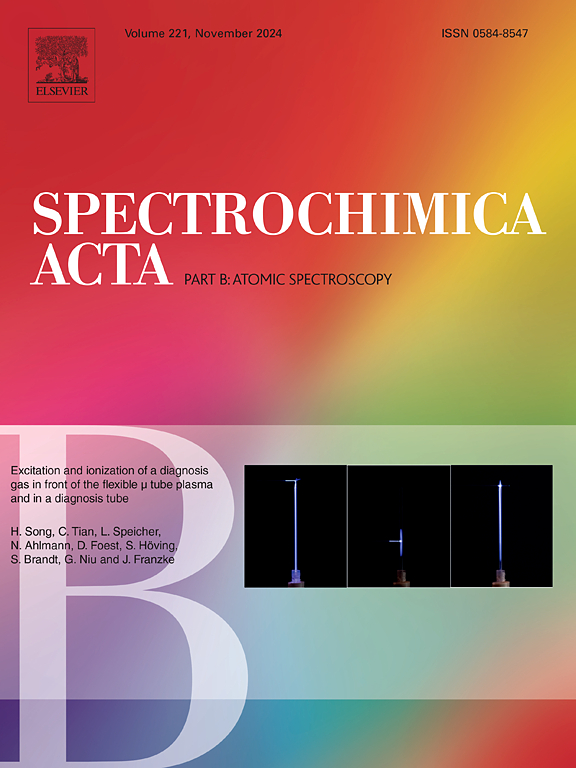Spectral calibration for atmospheric particles analysis under non-precise focusing conditions using LIBS combined with transfer learning
IF 3.2
2区 化学
Q1 SPECTROSCOPY
引用次数: 0
Abstract
Elemental analysis of atmospheric particulate matter is crucial for air-pollution research. However, the dispersed nature of these particles can lead to variations in the laser-focusing positions, which cause fluctuations in the laser-induced breakdown spectroscopy spectral data. In this study, a transfer-learning approach called transfer component analysis (TCA) is introduced to reduce the impact of spectral-data fluctuations on quantitative-analysis model predictions. First, dictionary learning combined with logistic regression is used to select the effective spectral data for which the laser successfully interacts with the particles. Second, TCA is used to migrate the data of pellet and dispersed atmospheric particles. Using partial least squares regression (PLSR), a TCA-PLSR model is established. The results indicate that the TCA-PLSR model significantly enhances the prediction performance, with test set coefficient of determination (RP2), root mean square error (RMSEP), and mean relative error (MREP) values of 0.9869, 60.33, and 0.1005, respectively. Compared with the PLSR model, RP2 improved by 55.05 %, RMSEP decreased by 81.09 %, and MREP decreased by 82.68 %. This method effectively detects metal concentrations in atmospheric particles and offers a scientific basis for air-pollution monitoring.

利用LIBS结合迁移学习的非精确聚焦条件下大气粒子分析光谱校准
大气颗粒物的元素分析对大气污染研究至关重要。然而,这些粒子的分散性会导致激光聚焦位置的变化,从而导致激光诱导击穿光谱数据的波动。在本研究中,一种称为转移成分分析(TCA)的迁移学习方法被引入,以减少光谱数据波动对定量分析模型预测的影响。首先,采用字典学习和逻辑回归相结合的方法,选择激光与粒子成功相互作用的有效光谱数据;其次,利用TCA对球团和分散的大气颗粒数据进行迁移。利用偏最小二乘回归(PLSR),建立了TCA-PLSR模型。结果表明,TCA-PLSR模型显著提高了预测效果,检验集决定系数(RP2)、均方根误差(RMSEP)和平均相对误差(MREP)分别为0.9869、60.33和0.1005。与PLSR模型相比,RP2提高55.05%,RMSEP降低81.09%,MREP降低82.68%。该方法可有效检测大气颗粒物中金属的浓度,为大气污染监测提供科学依据。
本文章由计算机程序翻译,如有差异,请以英文原文为准。
求助全文
约1分钟内获得全文
求助全文
来源期刊
CiteScore
6.10
自引率
12.10%
发文量
173
审稿时长
81 days
期刊介绍:
Spectrochimica Acta Part B: Atomic Spectroscopy, is intended for the rapid publication of both original work and reviews in the following fields:
Atomic Emission (AES), Atomic Absorption (AAS) and Atomic Fluorescence (AFS) spectroscopy;
Mass Spectrometry (MS) for inorganic analysis covering Spark Source (SS-MS), Inductively Coupled Plasma (ICP-MS), Glow Discharge (GD-MS), and Secondary Ion Mass Spectrometry (SIMS).
Laser induced atomic spectroscopy for inorganic analysis, including non-linear optical laser spectroscopy, covering Laser Enhanced Ionization (LEI), Laser Induced Fluorescence (LIF), Resonance Ionization Spectroscopy (RIS) and Resonance Ionization Mass Spectrometry (RIMS); Laser Induced Breakdown Spectroscopy (LIBS); Cavity Ringdown Spectroscopy (CRDS), Laser Ablation Inductively Coupled Plasma Atomic Emission Spectroscopy (LA-ICP-AES) and Laser Ablation Inductively Coupled Plasma Mass Spectrometry (LA-ICP-MS).
X-ray spectrometry, X-ray Optics and Microanalysis, including X-ray fluorescence spectrometry (XRF) and related techniques, in particular Total-reflection X-ray Fluorescence Spectrometry (TXRF), and Synchrotron Radiation-excited Total reflection XRF (SR-TXRF).
Manuscripts dealing with (i) fundamentals, (ii) methodology development, (iii)instrumentation, and (iv) applications, can be submitted for publication.

 求助内容:
求助内容: 应助结果提醒方式:
应助结果提醒方式:


